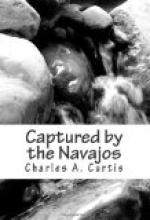“Who was Ferrier?” Frank asked.
“He was a discharged California volunteer, who rode the express before Mr. Hudson.”
“Do you think Mr. Hudson knew his predecessor had been killed?”
“Yes; the incident was much talked of at the time.”
We were nearing the object in the road. Suddenly the mules caught sight of it, backed, and crushed the ten-gallon keg under the axle against a bowlder—a serious mishap, as our after experience will show. Walking on, we came to the mutilated bodies of two men, several yards apart, whom we had no difficulty in recognizing to be the tradesmen Bell and Sage. With axe, bayonets, and tin cups we dug a shallow grave beside Ferrier’s. We placed the bodies side by side, and heaped a pyramid of stones above them.
The courier again bade us good-bye, and we went on. The rest of the ride through the mountain-pass was accomplished without adventure, and evening found us encamped at Willow Springs. The boys shot a few quail here, of the variety known as the California quail, distinguished by an elegant plume of six feathers on the top of its head. Clary broiled them for breakfast.
The road on the following day was so rough that for much of the way we were unable to move faster than a walk—the slow walk of draught animals. When near a place called Soldiers’ Holes, on account of some rifle-pits sunk there, the corporal called my attention to a pool of blood in the road.
A close examination led us to believe that two men had fallen, that one had been wounded, and that a second party had come and taken the wounded man away. The locality was well adapted for a surprise. On the left was a growth of dense shrubbery extending from the road to the foot of the mountain-range. On the opposite side was an open plain.
We were moving on again, when Frank remarked:
“There seems to have been a big gathering of Apaches along this road.”
“Yes; a war-party bent on mischief. They have struck at two points, and I fear a third—Date Creek—may have been attacked by this time. That is where we are to pass the night.” Then turning to Corporal Duffey, I continued: “The road from here to the creek is soft and loamy, and we are not likely to make much noise; caution the men to be quiet and not show themselves outside the track. If the Indians are at the ranch it will be best for us to appear there unexpectedly.”
“Do Indians never stand up like white men, and fight?” asked the younger boy.
“Frequently, but their system is different from ours; however, our latest military tactics appear to be modelled on theirs.”
Although this section of our journey was but twenty-five miles long, our rate of progress had been so slow that the day was nearly closed when we came in sight of the lines of cottonwoods that bordered Date Creek. We turned at last sharply to the left, and began a descent through a narrow ravine towards the creek. We were nearing its widening mouth when a half-dozen sharp reports of fire-arms broke upon our ears. A halt was ordered and the men directed to prevent the animals from betraying our presence by whinnying or braying. Telling Sergeant Henry to remain behind and keep Vic with him, I went in advance with Sergeant Frank.




